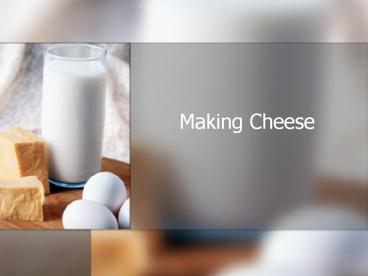Making Cheese - PowerPoint PPT Presentation
1 / 9
Title:
Making Cheese
Description:
Making Cheese Making Cheese Warm the milk slightly Add a started of lactic-acid producing bacteria Milk becomes slightly-acid, rennin is added. – PowerPoint PPT presentation
Number of Views:349
Avg rating:3.0/5.0
Title: Making Cheese
1
Making Cheese
2
Making Cheese
- Warm the milk slightly
- Add a started of lactic-acid producing bacteria
- Milk becomes slightly-acid, rennin is added.
This causes the milk protein to settle out.
(Renin enzyme which causes milk to settle out) - Milk protein casein coagulates to form the curd.
- Curd is then cut to separate the whey, clear
liquid that contains some of the water-soluble
substances in milk. - After curd is cut to remove the whey, it is mixed
with salt. - Packed into cheesecloth-lined hoops. Cheese is
called green cheese at this point. - Dried for several days
- Coated with hot paraffin-prevents moisture loss
during curing - Cheese is placed in a ventilated room at a
controlled temperature about 50F, to develop the
desired flavor.
3
- Warm Milk
- Add a starter to separate curds (solids) from
whey (liquids) (Unripe cheese stops here
cottage cheese) - Mix curd with salt and cover with cheese cloth
and wax for aging - Place in a ventilated room to cure
- Ripened cheese's longer for a stronger
taste/flavor - Ex. Mozzarella, cheddar and parmesan
4
Coagulating Milk Protein
- Milk contains many different proteins, but 2
major ones are involved in making cheese. The
two proteins are casein and whey. When an acidic
food or milk-clotting enzymes such as rennin are
added to milk, the two proteins separate. Casein
clumps together into solid groups called curds,
as in cottage cheese. The whey is a thin, bluish
liquid that remains after the curds clump. Many
different dairy products are made by turning
proteins into curds
5
Types of Cheese
- Ripened cheese aged cheese, made from curds to
which ripening agents (bacteria, mold, yeast were
added) - Blue cheese, brie, camembert, cheddar etc.
- Unripened cheese made from curds that have not
been aged - Cottage cheese, cream cheese, mozzarella etc.
6
Cooking Cheese
- Heat cheese just long enough to melt, if
overcooked cheese get stringy and tough - To speed up cooking time, shred, grate, or cut
cheese into small pieces. - Be careful to microwave cheese
- To lower fat in recipes with cheese, choose
sharp-flavored varieties since they have more
flavor you can loose less
7
Using Yogurt in Recipes
- You can substitute yogurt for many recipes that
use sour cream, cream cheese, milk and mayonnaise - Yogurt can be cooked, baked or frozen
- Cooking yogurt at moderate temperature for only a
short time and at a low temperature because it
can curdle - You can thicken yogurt by letting the whey drain
off
8
Other Categories of Cheese
- Cold Pack Cheese
- A blend of ripened cheese processed without heat.
- Flavorings and seasoning are added.
- Pasteurized Process Cheese
- A blend of ripened cheese processed with heat.
- Processed American cheese
- Cheese Spread
- Cheese food
9
Questions
- What is the difference between ripened and
unripend cheese? - What ingredient can you substitute for sour
cream? - What happens to cheese that is cooked to long?
- What are the two main proteins when making
cheese?






















![Cheese Powder Market, Global Industry Size Forecast [Latest] PowerPoint PPT Presentation](https://s3.amazonaws.com/images.powershow.com/9974062.th0.jpg?_=20231212019)








